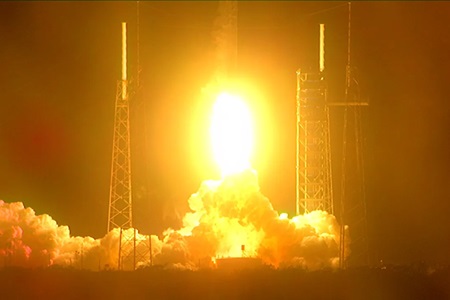The PACE mission will use the instruments aboard to study climate changes impact on Phytoplankton and other microscopic particles in both the water and the air.

NASA’s satellite mission, known as PACE (Plankton, Aerosol, Climate, ocean Ecosystem), aimed at studying ocean health, air quality, and climate change’s effects, launched into orbit on February 8. The satellite was launched aboard a SpaceX Falcon 9 rocket from Space Launch Complex 40 at Cape Canaveral Space Force Station in Florida. NASA confirmed signal acquisition from the satellite about five minutes after launch, and it is performing as expected.
Speaking about the launch, NASA Administrator Bill Nelson said: Congratulations to the PACE team on a successful launch. With this new addition to NASAs fleet of Earth-observing satellites, PACE will help us learn, like never before, how particles in our atmosphere and our oceans can identify key factors impacting global warming. Missions like this are supporting the Biden-Harris Administrations climate agenda and helping us answer urgent questions about our changing climate.
The PACE mission will utilise its hyperspectral ocean colour instrument to study oceans and water bodies across a spectrum of light. This will enable researchers to track phytoplankton distribution globally and identify changes in the marine environment, aiding in forecasting fisheries’ health and tracking harmful algal blooms.
Additionally, the satellite carries two polarimeter instruments to detect sunlight interactions with atmospheric particles, providing insights into aerosols, cloud properties, and air quality on local, regional, and global scales.
From hundreds of miles above Earth, the PACE mission will study the impact of tiny, often invisible things: microscopic life in water and microscopic particles in the air.
Karen St. Germain, Director, Earth Science Division, Science Mission Directorate, at NASA Headquarters in Washington, said: Observations and scientific research from PACE will profoundly advance our knowledge of the oceans role in the climate cycle. The value of PACE data skyrockets when we combine it with data and science from our Surface Water and Ocean Topography mission ushering in a new era of ocean science. As an open-source science mission with early adopters ready to use its research and data, PACE will accelerate our understanding of the Earth system and help NASA deliver actionable science, data, and practical applications to help our coastal communities and industries address rapidly evolving challenges.
Marjorie Haskell, PACE programme executive at NASA Headquarters, added: Its been an honour to work with the PACE team and witness firsthand their dedication and tenacity in overcoming challenges, including the global pandemic, to make this observatory a reality. The passion and teamwork are matched only by the excitement of the science community for the data this new satellite will provide.
Earths oceans are responding in many ways to climate change from sea level rise to marine heat waves to a loss of biodiversity. With PACE, researchers will be able to study climate changes effects on phytoplankton, which play a key role in the global carbon cycle by absorbing carbon dioxide from the atmosphere and converting it into their cellular material. These tiny organisms drive larger aquatic and global ecosystems that provide critical resources for food security, recreation, and the economy.
Jeremy Werdell, PACE project scientist at NASAs Goddard Space Flight Center in Greenbelt, Maryland, stated: After 20 years of thinking about this mission, its exhilarating to watch it finally realized and to witness its launch. I couldnt be prouder or more appreciative of our PACE team. The opportunities PACE will offer are so exciting, and were going to be able to use these incredible technologies in ways we havent yet anticipated. Its truly a mission of discovery.
NASA’s Launch Services Programme managed the mission’s launch services, while NASA Goddard managed the mission itself, including spacecraft and instrument development and testing. Collaborators include the University of Maryland, Baltimore County, and a Dutch consortium led by the Netherlands Institute for Space Research and Airbus Defence and Space Netherlands, responsible for building the polarimeter instruments.













































































